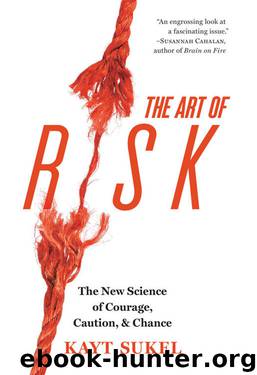The Art of Risk: The New Science of Courage, Caution, and Chance by Kayt Sukel

Author:Kayt Sukel [Sukel, Kayt]
Language: eng
Format: epub
ISBN: 9781426214738
Publisher: National Geographic Society
Published: 2016-03-01T07:00:00+00:00
TALKING ABOUT SOME INTUITION
You may be wondering why more automaticity is such a good thing. After all, we already said that you need your gas, that increased basal ganglia activity, and your brakes, that prefrontal regulator, working together to make optimal decisions. So why would easing up on the brakes be any kind of benefit if you are about to climb a 1,000-foot wall without safety equipment? How is it going to help you?
It’s a matter of resource allocation. If you have only so much cognitive effort to go around, you want to make sure it’s focused on the right variables in your risk equation. You want to make sure your brain and body are working in a highly efficient state. You want to be able to rely on your fast-thinking systems so that your cognitive effort can deal with something other than the basics. You want to maximize attention and working memory all while regulating stress. And these are all things that can improve performance, even in risky situations.
“If you have practiced enough that you are an expert in a particular field, you have a lot of information about that field on hand. You can anticipate what comes next, what you need to do, the best way to respond to a situation, and so on,” says Michael Posner, a pioneering neuroscientist who has been studying attention at the University of Oregon for decades. “That means you can deal with things in your field that people without that expertise can’t. It allows you to deploy your attention faster and in a different way.”
And it can allow you to approach your decision-making with some unconscious intuition. What exactly is intuition? Scientifically speaking, it’s simply synchronizing your current decision-making situation with past experience. But it doesn’t require your conscious-level cognitive resources to do so.
“People want to talk about intuition like it’s some kind of mystical or religious thing,” Rice University’s Dane says, chuckling. “From a scientific standpoint, however, it’s a pattern-matching process. You are essentially mapping all the experiences you’ve accrued to the situation at hand—and it’s happening at a very unconscious, automatic level. Often, you aren’t even aware of why or how you started moving toward a particular decision.”
So, we aren’t necessarily aware of a lot of things that are influencing our decisions. J. David Creswell, director of Carnegie Mellon University’s Health and Human Performance Laboratory, wondered how unconscious processing—the very stuff of which intuitions are made—might influence decision-making on a task. He, along with former student James Bursley, recruited 27 students to have their brains scanned while making a decision about cars and other consumer items. First, participants were given information about the various products. For the car, for example, they were offered 12 attributes for 1.75 seconds each about each choice: things like “Car A has leather seats,” and “Car B has bad gas mileage.” Each car had a different distribution of positive and negative attributes, with one showing a much higher number of positive than negative ones—making it the optimal choice.
Download
This site does not store any files on its server. We only index and link to content provided by other sites. Please contact the content providers to delete copyright contents if any and email us, we'll remove relevant links or contents immediately.
Rewire Your Anxious Brain by Catherine M. Pittman(18322)
Talking to Strangers by Malcolm Gladwell(12889)
The Art of Thinking Clearly by Rolf Dobelli(9930)
Mindhunter: Inside the FBI's Elite Serial Crime Unit by John E. Douglas & Mark Olshaker(8722)
Becoming Supernatural by Dr. Joe Dispenza(7845)
Change Your Questions, Change Your Life by Marilee Adams(7386)
The Road Less Traveled by M. Scott Peck(7284)
Nudge - Improving Decisions about Health, Wealth, and Happiness by Thaler Sunstein(7261)
The Lost Art of Listening by Michael P. Nichols(7170)
Mastermind: How to Think Like Sherlock Holmes by Maria Konnikova(6944)
Enlightenment Now: The Case for Reason, Science, Humanism, and Progress by Steven Pinker(6879)
Win Bigly by Scott Adams(6833)
The Way of Zen by Alan W. Watts(6292)
Daring Greatly by Brene Brown(6231)
Big Magic: Creative Living Beyond Fear by Elizabeth Gilbert(5361)
Grit by Angela Duckworth(5303)
Men In Love by Nancy Friday(4972)
Ego Is the Enemy by Ryan Holiday(4965)
Altered Sensations by David Pantalony(4872)
